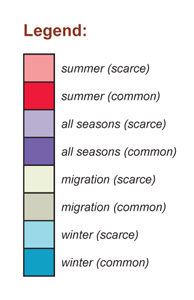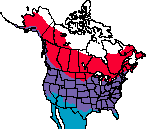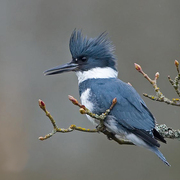Belted Kingfisher
General Description
The Belted Kingfisher is a medium-sized, stocky bird with a large, crested head, and a long, solid bill. The bird has a small white spot by each eye, at the base of the bill. Its back is an overall slate blue color. The white belly is transected by a slate blue band, topped with a white collar. The female has an additional rufous band and rufous coloring on the sides of the belly.
Habitat
Belted Kingfishers are found along shorelines and wetlands in fresh and salt water environments. They require sandy vertical banks for nest burrows and clear water so they can see their aquatic prey.
Behavior
Belted Kingfishers perch or hover over open water, watching for prey. Once prey is sighted, they dive headfirst into the water and seize it with their bills. Typically prey is taken near the surface, and the birds do not submerge themselves completely. Belted Kingfishers are highly territorial and vigorously defend their territories. Their most common call is a dry rattle, often given in flight.
Diet
Belted Kingfishers almost always take food from the water, feeding predominantly on small fish. They will also prey on crayfish, frogs, tadpoles, and other aquatic dwellers.
Nesting
The Belted Kingfisher nests in burrows dug in sandy banks. Two of its toes are fused together and act as a shovel for digging these burrows. Both the male and the female incubate the 6-7 eggs that she lays in the burrow. Both parents regurgitate fish to feed the young.
Migration Status
Across their range, some kingfishers migrate as far south as northern South America. In parts of Washington where water remains open through the winter, kingfishers can be found year round; others in the state are migratory. They leave interior and higher elevation breeding grounds by September.
Conservation Status
According to breeding bird surveys, the population in Washington has remained stable over the last 35 years. Kingfishers appear to be less susceptible to environmental contaminants than other fish-eating birds, possibly because their diet is restricted to smaller fish. Availability of suitable banks for nesting is a limiting factor in distribution and abundance. Water quality and nesting sites must be protected for successful reproduction.
When and Where to Find in Washington
Kingfishers are common year round (as long as there is open water) in wetlands and along rivers and streams at elevations below the sub-alpine fir and mountain hemlock zones throughout Washington, and along the coasts.
 Abundance
Abundance
| Ecoregion | Jan | Feb | Mar | Apr | May | Jun | Jul | Aug | Sep | Oct | Nov | Dec |
|---|---|---|---|---|---|---|---|---|---|---|---|---|
| Oceanic | ||||||||||||
| Pacific Northwest Coast | F | F | F | F | F | F | F | F | F | F | F | F |
| Puget Trough | F | F | F | F | F | F | F | F | F | F | F | F |
| North Cascades | F | F | F | F | F | F | F | F | F | F | F | F |
| West Cascades | F | F | F | F | F | F | F | F | F | F | F | F |
| East Cascades | F | F | F | F | F | F | F | F | F | F | F | F |
| Okanogan | F | F | F | F | F | F | F | F | F | F | F | F |
| Canadian Rockies | F | F | F | F | F | F | F | F | F | F | F | F |
| Blue Mountains | R | R | R | U | U | U | U | U | U | U | U | U |
| Columbia Plateau | F | F | F | F | F | F | F | F | F | F | F | F |
Washington Range Map

North American Range Map




